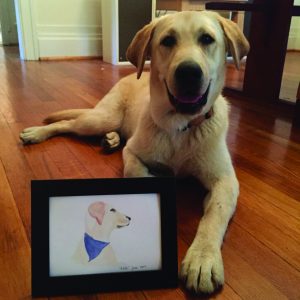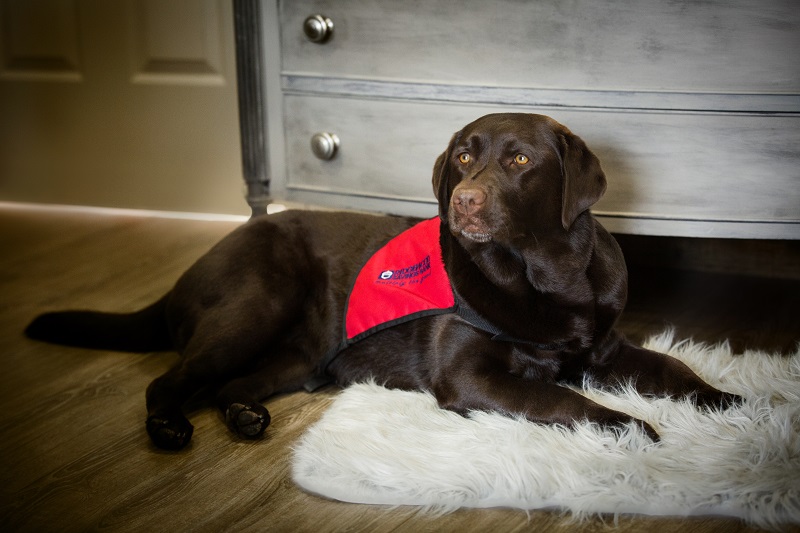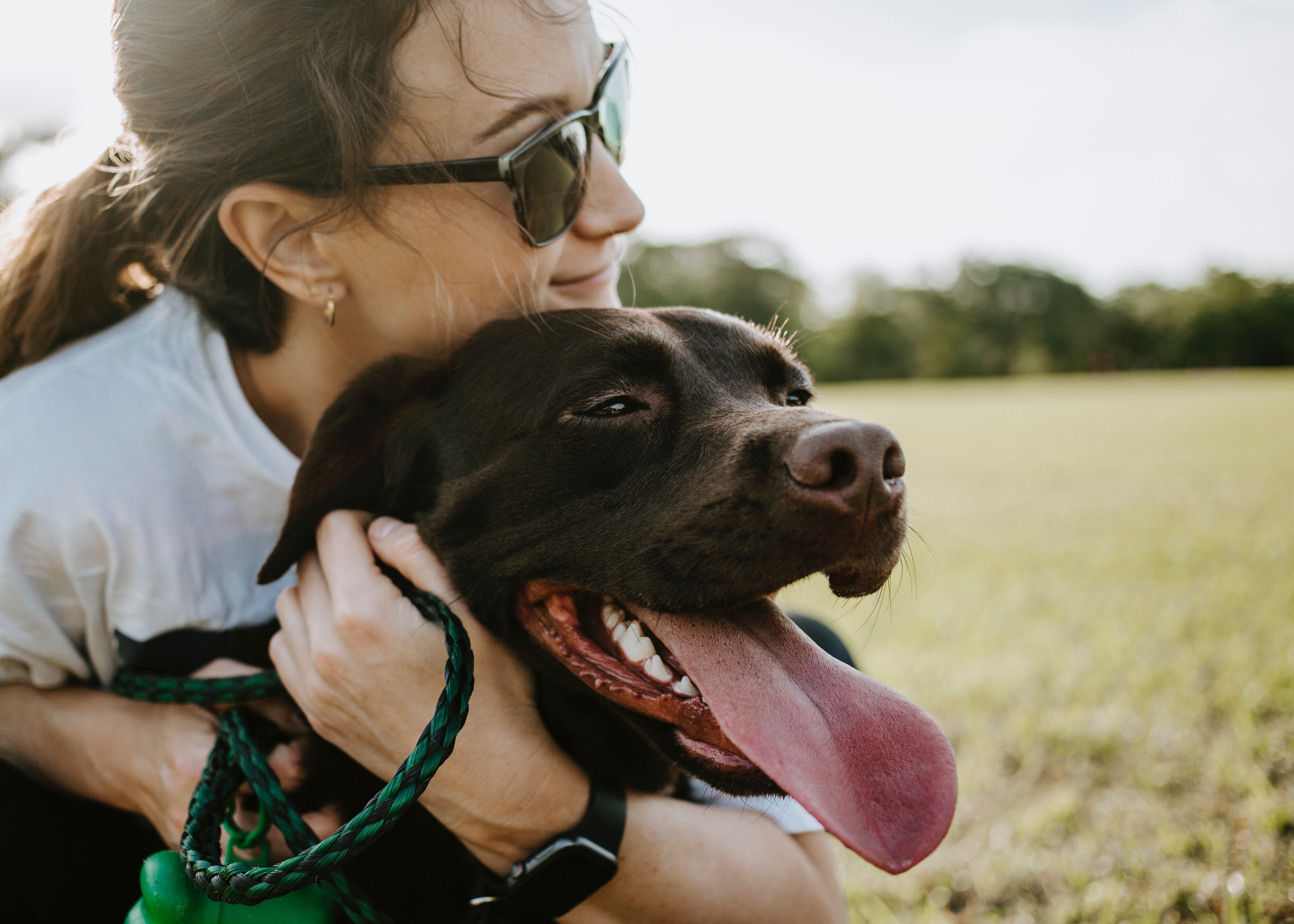by Jason Smith
In the November/December 2014 and January/February 2015 issues of Just Labs, I relayed our adventure as a breeding host family for Leader Dogs For the Blind (www.leaderdog.org) as we helped Cici bring in a new litter of future Leader Dogs. Well, prospective Leader Dogs. Not all of her six puppies will make the cut; if they don’t, dogs are “career changed,” and many go on to perform other services or even just be wonderful companion pets.
There is an interim stage between their birth and their formal training, though, and that’s at the “puppy raiser” stage. After we returned Cici’s litter to Leader Dogs For the Blind, the pups were then placed into homes to begin their early stages of training. “Leader Dog asks for a one year commitment from puppy raisers,” says Deb Donnelly, Puppy Development Supervisor for Leader Dogs For the Blind. “That’s a 24/7 job and a lot of hours!” And it’s all volunteer work, too, just like our work is hosting a breeding stock mom.
“A puppy profiler will lead the potential applicant through a series of questions regarding their home, lifestyle, and experience, and how puppy raising will impact their lives,” says Donnelly. “Once the potential raiser has gone through the profiler, he or she will have the opportunity to read the puppy raiser job description, and apply to raise a puppy.
“We do screen our applicants,” Donnelly continues. “If there are pets in the home, we call their veterinarian to make sure they are up to date on vaccinations. If the applicant is under the age of 18, a parent must be the primary raiser. There must be a licensed driver in the home.” And an important requirement: the puppy raiser must travel to Rochester Hills, Michigan, to pick up the dog and for regular training sessions. If any concerns arise on the application, a committee at Leader Dog will discuss it.
Giving the pup back to Leader Dog after raising him or her for a year is a point most people focus on when wondering if they could perform this service – and it’s a serious point to consider. However, Donnelly provides a good statistic to support how rewarding the experience can be. “Seventy percent of our raisers raise more than one puppy,” she says. “Many of them pick up a new puppy the day they return their current puppy for training. Repeat raisers are allowed to apply to raise again once their current puppy is nine months old, so Leader Dogs can see if they are following our guidelines.”
And what happens should a Future Leader Dog not, in fact, become a Leader Dog? “A dog can be career changed for medical, behavior, or work reasons,” says Donnelly.
“About fifty percent of the dogs returned for training become working guides. Some of our career changed dogs will have a different service or work career. Our puppy raisers, if they have followed our guidelines, do have the option to take the puppy they have raised back into their home.”
A few weeks after taking Cici’s puppies back to Leader Dogs For the Blind in December 2014, we heard from three individuals who brought home a “Cici pup.” We had assembled a packet of photos, magazines of our story with Cici, and our contact information; it was up to the puppy raisers to contact us.
Amy Schupska is raising Atlas (formerly Buster, Mr. Blue); Val Bensen has Lettie (formerly Pixie, Ms. Pink); and Rachael Hone is bringing along Elvis (formerly Reggie, Mr. Red, and the pup that nearly gave me an ear piercing when he was four weeks old). They even all met (again) at an early training day!
Why did you get involved as a puppy raiser for Leader Dogs For the Blind?
Val Benson: Back in 2002, my brother-in-law received his first Leader Dog. I was hooked. It may have taken me 11 years, but I wanted to give back. In 2013 while watching the news, I saw there was a need for Leader Dog puppy raisers, and I said, “Why not?”
Amy Schupska: I got involved with Leader Dog for a few reasons. I remember seeing a puppy raiser when I was a kid growing up in Midland, Michigan. My college roommate’s family raised puppies. She told me that she didn’t think I could do it – “it” being the “giving them up” part.
The other reason I got involved is because after my mom died in 1999, she donated through Gift of Life. Her corneas were transplanted to help a woman in Bloomfield Hills, Michigan, be able to see again.
Leader Dogs has been such a blessing in my life. The dogs help me to go out in public more and in doing this, I am meeting new people while sharing the Leader Dogs mission. Just reflecting on the dogs my husband and I have raised, it is awesome to think about the role we played in their lives. A couple went on to become Leader Dogs, a few are therapy dogs, and a couple have very cushy lifestyles as pets! I saw one of my working dogs last fall. He has been a working Leader Dog for almost eight years in Taiwan. The experience was breathtaking. Watching Louie walk through crowded areas that had food at nose level and he didn’t even acknowledge it other than walking his partner safely through. At 9½ years old, Louie will be retiring home to us in early August of this year.
Rachael Hone: I got involved as a puppy raiser after my good friend and former roommate brought home her Future Leader Dog, Ruger, in 2013. After being introduced to the program, and now working with faculty and staff treating blindness and visual impairments at the Kellogg Eye Center at University of Michigan, I knew it was the right time to raise my very first pup! I got involved because I know the importance and value of Leader Dogs, and see daily how their training helps to support the independence of visually impaired people across the world.
Can you tell us briefly your responsibilities? How long will you have the pup? Do you have to attend training days?
Val: Our responsibilities as a puppy raiser are to socialize, teach basic obedience, and accept full responsibility for maintaining a happy, healthy puppy. We raise the puppy for at least a year while attending monthly meetings with our Leader Dog counselor. Any extra training of the puppy is our choice.
Amy: My job as a volunteer puppy raiser is to provide Atlas with a variety of positive experiences such as riding on different types of transportation, going to places that he will be asked to settle down in (such as a restaurant or movie theater) versus moving more through crowds such as at a theme park or store. There is a fine line in puppy raising between socializing a puppy and getting them used to the many different scenarios they may come across and overwhelming them. One of the most important things we can learn about our puppy through experience is to recognize signs of distress.
This helps us gauge if we need to go a little slower with exposure or to remove them from somewhere if it is too stressful.
The other main part of our job is public education. We teach the public the importance of asking before petting a service dog, and how distracting a dog that is working is a bad idea.
We not only teach the puppy basic obedience such as sit, down, stand, come, stay; but we also teach them to settle in distracting environments, to walk in heel position on staircases, behave calmly to be pet by strangers, and also to avoid being distracted by other dogs and people when they are “working.”
We have them from seven weeks of age until they are 12-14 months old. We are required to be seen by a puppy counselor at least once a month for training sessions.
Rachael: I am responsible for, primarily, the socialization, manners, and basic obedience. I will have Elvis until around his first birthday in October, though have the option of returning as late as November. I am able to take Elvis with me to work, so as part of my daily routine, he is exposed to car rides, navigating traffic and parking lots, offices, elevators, cafeterias, etc.
Starting him so young with a routine has been incredible to his well-being. Now at eight months, he isn’t startled or bothered by any sights or sounds or touch. He also has an expectation of what I want and will do many if not most of his commands on his own (sitting for meals, entry, heeling while walking, etc.). This prepares him for his on-site training as he is calm, intelligent, and happy to please. We attend monthly outings and training sessions, as well as a bi-monthly training day on campus at Leader Dogs.
What are the goals Leader Dogs For the Blind would like you to accomplish as a puppy raiser?
Val: That we produce a well-socialized dog, willing to learn and work hard at the future task ahead.
Amy: The main goals I have as a puppy raiser are to have a dog that has been properly socialized and exposed to a variety of environments and people, to have raised a puppy that enjoys learning and working as a “team,” and also to establish a good settle or down with them.
By the time the puppy is 10-12 months, we must also complete an In-For-Training Assessment or IFT. This provides the organization with a “snapshot” of the puppy. We must demonstrate basic obedience and some other skills that we have been working on with them since they were seven weeks old. A volunteer assessor grades the puppy on a rubric system. Leader Dog is still working to correlate aspects the assessment with likelihood of graduation.
Rachael: As a puppy raiser, we are in a unique position to take the pup everywhere. This helps to socialize the pup to all sorts of sights and smells and people, which is crucial. Also as important, basic obedience, which includes potty-training and manners. As a puppy raiser we can help acclimate them into the world and give them love and smarts, which builds the confidence and foundations needed to succeed in the training program. The goals are to meet the IFT guidelines, which by following the training manual and attending sessions, pups and their caretakers are able to learn together.
 Tell us a little about your current Future Leader Dog (FLD).
Tell us a little about your current Future Leader Dog (FLD).
Val: FLD Lettie is my second puppy I’ve raised. She is a lot like me – hyper, spirited, and never quits, always on the go.
Amy: Atlas is my ninth Leader Dog puppy I have raised. He has a very calm and eager-to-please personality. One of the things I like best about him is that he listens and obeys on the first command in the majority of settings. All I have to do if he is distracted is say his name or tap his side, and he redirects his attention to me. This is an awesome “feature”!
He is very good about adapting his play style to the dogs he is playing with. He can play calm and slow (even lying down) with puppies and small dogs. He will play a little more energetic with other dogs his age and size.
Rachael: Elvis is a character. He is so silly! He is a true Lab, through and through. I say he is silly because he is such a lover, and I do not think he is aware of his big size! When we play, or I arrive back after being gone, he always grabs for a toy to have in his mouth, and I sit on the ground to teach him to stay on all fours. He will walk around me in circles, mouth full of two or three toys [Editor’s note: He must get this from his mom, Cici], with his tail wagging and whipping around, just so truly delighted! He has a very smiley face and overall demeanor, but as soon as I have a treat or we are going over his calming exercises, he gets very serious and an intense look on his face. He has gotten very vocal in his older age – not barking, but unique yips and whimpers and groans, dependent upon his need or mood. He is so smart and I really think he is trying to communicate like a human! As he gets bigger and stronger, training and consistency can be more difficult with his rising confidence, but he is so kind and intelligent that any puppy frustration becomes no problem at all.
What have been the biggest successes so far?
Val: House breaking has been a breeze. Lettie and I took a trip by car down to Mississippi, and she was an excellent companion. Ten hours on the road only stopping for park time, and she did awesome. [Editor’s note: Park is the command Leader Dogs For the Blind dogs are told as they do their business as a means to get the dog to hurry up.]
Amy: Atlas is very calm around children. A lot of the Labs and goldens get very distracted and excited around kids, but he is calm around them. He walks on a loose leash and rarely pulls. I told him the day I got him, “Your dad is ninety pounds. I will teach you to walk on a loose leash because I will not be pulled by a horse.” I think he listened!
Rachael: I feel the biggest successes shine in his socialization. Whether I am vacuuming or playing loud music or bringing over a variety of guests or passing squirrels on walks, he is never bothered or distracted or anxious. He is truly comfortable in every surrounding I have had him in, which I feel is unique to many other pups I have met. He is my go-with-the-flow guy. I feel this will really help him be successful in his training program.
What have been your biggest challenges?
Val: Loose-leash walking and meeting and greeting people have been and continues to be a challenge. Lettie just loves people.
Amy: We haven’t really had any challenges per se. The thing I work on him the most with is walking calmly up staircases. He is exceptional going down.
The other thing I have to remind him about is not to paw at people when he is excited. He loves to carry around toys and make little “arr-arr-ooo” noises and paw at our legs especially in the morning. [Editor’s note: Hmm… the toys again, just like Elvis. Cici makes these noises, too, also in the morning.]
In the last month, he has started to sniff more when he is out working. We work on getting his attention, doing leave-its and redirecting him to help him overcome this.
Rachael: The biggest challenges were basic puppy behaviors, which really meant the behaviors I had to change! We are quickly taught that any object left on the ground is fair game for a puppy! So I have lost some socks and shoes, but this is to be expected. At his older age, I feel it can be a challenge to control his “excitable hellos.” Labs are social dogs, and it can be overwhelming because of his size to stay calm and on all fours!
Does your FLD have an interesting or funny quirk?
Val: Mealtime is loud and robust. Lettie will bark and spin in circles while I get the food out of the bag. She does sit and wait but leaves a trail of drool while doing so. [Editor’s note: Another trait from mom. Every mealtime ends with a wet paper towel cleaning the floor where Cici sat waiting for us to fill the bowl. Thick, industrial-strength drool, too.]
Amy: He has a morning routine of walking around with a toy in his mouth. He wags his tail a ton and “talks” with the toy in his mouth. When we come home from somewhere, too, he does this for the new person and grabs the first toy he sees. [Editor’s note: Yep… that’s Cici…]
Rachael: My silly little guy – most things Elvis does are funny and interesting! Notably though is his habit to sleep, play, and rest on his back. His favorite is to find a wall and belly-up, knocked out cold snoozing, full tummy exposed! I say he is very confident and comfortable with himself. (And having Googled these traits, it does mean he feels safe and comfortable!) He is also so vocal and you’ll hear tired grunts, sighs, huffs, puffs, sneezes, groans, moans, whimpers… this dog is gonna let you know what is going on! It always makes me laugh to hear a long-winded murmur and look over and see him sprawled out, flush with the wall, snoozing on his back. Being a puppy is tough work!
 Do you have a favorite story so far? How did you come up with his or her name?
Do you have a favorite story so far? How did you come up with his or her name?
Val: I would have to say I don’t have a favorite story; her name is her story. I chose the name Lettie in remembrance of my best friend Paulette who passed away from cancer. They both will forever hold a special spot in my heart.
Amy: We attended a Dinner-In-The-Dark in Pennsylvania when Atlas was 6½ months old. Before the dinner, they blindfolded us in the hallway, and we had to walk into the dining hall without being able to see where we were going. I had Atlas walking next to me, and my other hand was on the person ahead of me shoulder. Atlas walked in a perfect heel. All of a sudden, I felt him stop and refuse to move forward. I reached my hand out, and he stopped because we were right by a wall! So cool to have him alert me so we could squeeze through to our chair.
As for Atlas’s name… I realized that by accident our first few puppies had names with five letters and an “L” in them. I’ve tried to keep this up, with the exception of Betty since she already had a name she responded well to at 15 weeks when we got her. My husband is a fan of mythology, and with Atlas’s dad, Gatsby, being a big dog, we thought he might also be 80-plus pounds!
Rachael: My favorite story comes from working here at Kellogg Eye Center. It was a truly “Michigan Difference, Little Victors” heart-touching moment. I was walking Elvis back inside through the lobby, and a little boy in a wheelchair was waving toward Elvis.
He had a patch over one of his eyes. I saw Elvis’s tail wagging back and took him over. I was worried he may try to hop up on his lap, but Elvis was so intuitive and stood at the little boy’s side while he pet his back, Elvis’s tail wagging like crazy. The little boy was giggling and laughing, stroking Elvis from his head to his tail. The mom looked to me and thanked me for bringing Elvis over and said her son loves dogs and that getting to pet Elvis made his week. It was a very touching moment.
I came up with the name Elvis before I met him; I knew I was getting a male and thought it’d be perfect for a pup. I wanted something that would work well for a working dog, too. He is so handsome, so it fits!
It’s normal, of course, that not every FLD goes on to be a Leader Dog, and they are “career changed.” If your FLD doesn’t qualify, what other career could you see your pup having?
Val: If FLD Lettie is career changed, I have already decided I’d keep her and get her certified as a therapy dog or try some agility training because she can really move.
Amy: Atlas would be fantastic at doing pet therapy with children. I could see him working with a reading program or visiting hospitals. He has a very calm nature.
Rachael: It varies – some days I think Elvis would be a great PTSD or anxiety pup. His intuition never ceases to amaze me. I was recently on the phone, having a panicked conversation, and Elvis was sitting by me. He got up, looked at me, and then sat back down but now on top of both of my feet, with his body as curled around my ankles as comfortably possible. I smiled, and felt safe, protected. It was like Elvis knew from the tone of my voice that I needed him to be there, to feel him, and feel okay. On more adventurous days, his sniffer is so active that I could see him working with search squads! Once on the trail of something… he is going there whether you want to or not!








